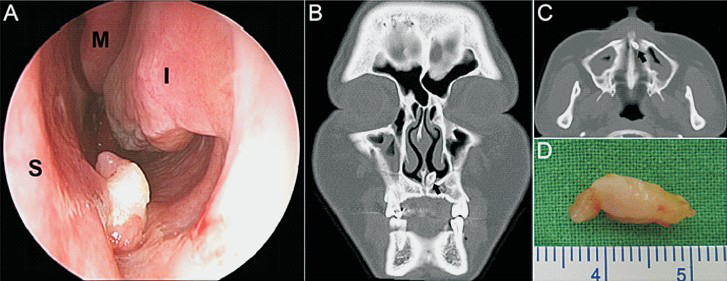Translate this page into:
Intranasal ectopic tooth
* For correspondence: doc30450@gmail.com
This is an open-access article distributed under the terms of the Creative Commons Attribution-Noncommercial-Share Alike 3.0 Unported, which permits unrestricted use, distribution, and reproduction in any medium, provided the original work is properly cited.
This article was originally published by Medknow Publications & Media Pvt Ltd and was migrated to Scientific Scholar after the change of Publisher.
A 43 year old woman presented to the otolaryngology outpatient department Tri-Service General Hospital, Taipei, Taiwan, in June 2013, with complaints of a left-sided nasal obstruction and purulent discharge for one year. She had no headache, facial pain, or facial pressure. Upon physical examination, the presence of a white mass covered with nasal mucosa was noted in gross rhinoscopy (Figure A). Computed tomography of the paranasal sinuses demonstrated a well-defined radiopaque mass resembling a tooth in the nasal cavity close to the nasal septum (Figure B and C). Endoscopic sinus surgery was performed to remove the mass, which was found to be a tooth of about 14 mm length (Figure D). During the follow up the patient was doing well three months postoperatively.

- Intranasal ectopic tooth. (A) The rhinoscopic image of a whitish tooth covered with a mucosal membrane in the left nose. S, nasal septum; M, middle turbinate; I, inferior turbinate. (B) and (C) Pre-operative coronal and sagittal computed tomography imaging of the paranasal sinuses, depicting a tooth in the left nasal cavity (black arrow). (D) The removed tooth was complete with a length of 14 mm.
An intranasal ectopic tooth is a rare clinical entity and the cause is unclear. The incidence of supernumerary teeth generally affects 0.1 to 1.0 per cent of the population, and of these cases only a small percentage develop an intranasal tooth1. It can occur in a variety of locations including the maxillary sinus, mandibular condyle, coronoid process, orbital and nasal cavities. The endoscopic approach to remove an intranasal ectopic tooth involves better exposure of the operative field23. Ectopic teeth may be confused with other nasal cavity masses, and nasal foreign bodies, rhinoliths and exostoses should be included in the differential diagnosis.
References
- Endoscopic extraction of an intranasal tooth: a review of 13 cases. Laryngoscope. 2001;111:1027-31.
- [Google Scholar]
- Endoscopic removal of an intranasal ectopic tooth. Int J Pediatr Otorhinolaryngol. 2003;67:79-81.
- [Google Scholar]





